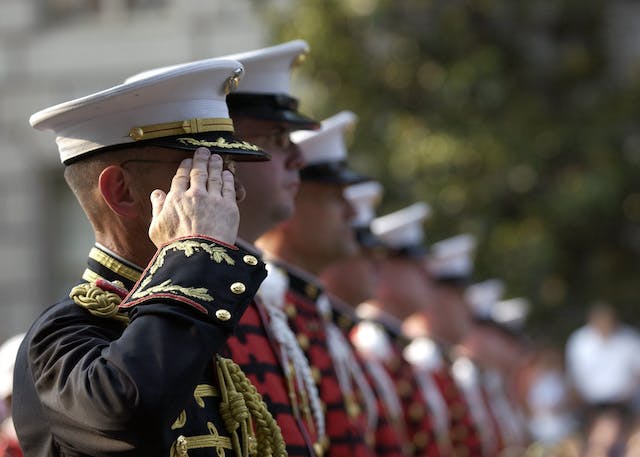
Where do modern military ranks come from? There is not one single point where they started. Many countries have different systems and they have all evolved over time. Most of the ones we use in the West came from Italian and French.
You don’t need ranks unless you have an organized army. In the beginning of history, tribes fought other tribes, but they wouldn’t have been called an army. The tribe might have a chief, and some people would be better at fighting than other people, but all able bodied men were expected to take up arms when they were needed. As tribes began to coalesce into larger groups of people and city states formed, larger armies became necessary. The Assyrian people of Mesopotamia were the first people to build a professional standing army. They came up with many innovations involving warfare, such as chariots and iron weapons. They organized their army into units of charioteers, cavalry, bowmen, and lancers and at some points they had over 100,000 people. There was a hierarchy that went from the king down to the lowest soldiers because no army of that size can function without dividing up the work. However, the majority of the soldiers were farmers and the army was bereft of people to fight during sowing and harvesting time. All of the empires that followed the Mesopotamian one have had structure in their armies. It is the only way to make them effective. They also had different names for those ranks. The Romans are probably the first people to have a very effective professional army. Their soldiers were paid and they were soldiers first and foremost. Many of them had to serve for 25 years before they could leave. Often, they were given land when they retired and sometimes Roman citizenship. The Roman army was broken up into about 17 different ranks.
All countries have different ranks and the armies, navies, and airforces within those countries have different ranks as well. To make it simple, let’s look at the origins of modern ranks in the army and let’s take America as representative of western countries. The US army has 29 ranks. They are: private – private first class – specialist – corporal – sergeant – staff sergeant – sergeant first class – master sergeant – first sergeant – sergeant major – command sergeant major – sergeant major of the army – warrant officer 1 – chief warrant officer 2 – chief warrant officer 3 – chief warrant officer 4 – chief warrant officer 5 – second lieutenant – first lieutenant – captain – major – lieutenant colonel – colonel – brigadier general – major general – lieutenant general – general – general of the army.
Where do these expressions come from? Let’s pick up on a few. The word “private” comes from the Latin word “privus”, which meant an individual person. It was first used as a military rank in the 16th century in Europe. In the 16th century, people had the choice to sign up to an army as an individual, rather than being forced to fight for a lord.
“Corporal” comes from the Italian “caporale”. In the 15th century, Italian armies were divided up into squares (squadra), and the leader of a square was the “capo de squadra”. By the 16th century, this had changed to “caporale”, which became “corporal” in French and was picked up in Engilsh.
“Sergeant” comes from “serviens” in Latin. A sergeant was a knight’s servant. They had to learn to fight for themselves and they were often given a group of serfs to command. They would have been good at fighting, but they wouldn’t have had enough money to become knights. The word came into English through French.
“Warrant officer” comes from the French word “warrant”, which means to protect or defend. Someone who is “warranted” is tasked with protecting something. The first warrant officer were created in the 11th century in Britain. The word “warrant” is the first part of “warranty”.
A “lieutenant” is someone who stands in for a person higher up in the chain of command. “Lieutenant” comes from the French “lieu”, which means place and “tenant”, which means holder. A lieutenant is basically a place holder for another rank. They are usually a deputy to the person who holds that rank and likely to step into that person’s rank, should it become available.
“Captain” comes from the Latin “capitaneus”, which meant “chieftain”. A captain headed a unit of soldiers, which, by the 16th century, had become about 100 to 200 men.
“Major” is the same word that we use to mean something that is great or big. “He is a major headache.” The rank of major started in the 16th century to distinguish the most important person out of a group of people with the same rank. There could be many sergeants, but one of them would be the major sergeants. It became a rank of its own in the 18th century.
“Colonel” comes from the Spanish “colunelas”, which meant columns. The Spanish army was organized into columns of about 1,000 men. The head of the column was called the “cabo de colunela”, which became “colonel”.
“General” comes from the Latin “generalis”, which means “of the whole”. The general was the person in charge of the whole army, and was usually appointed by the king. The ran began as captain general in the 16th century, then became colonel general in the 17th century, and finally, just general in the 18th century. The additions of major and lieutenant mean exactly the same. The major general is the most major of the generals. The lieutenant general is the place holder for the general. The general is the man in charge of the whole unit. And this is what I learned today.
Sources
